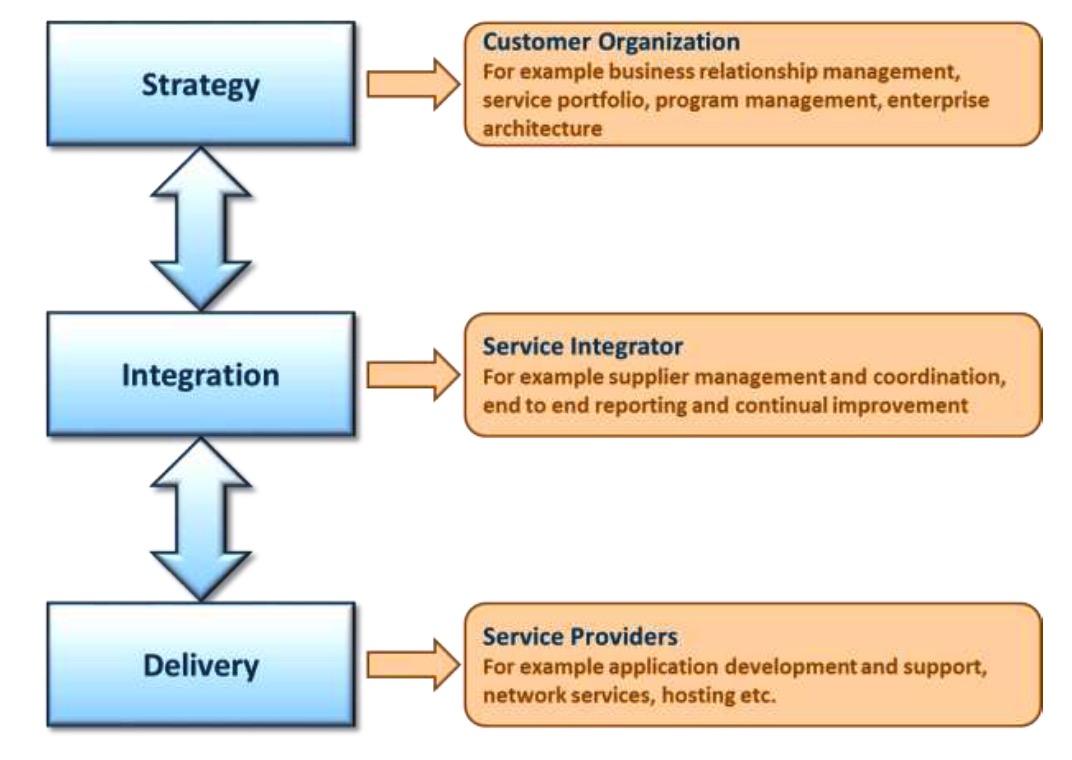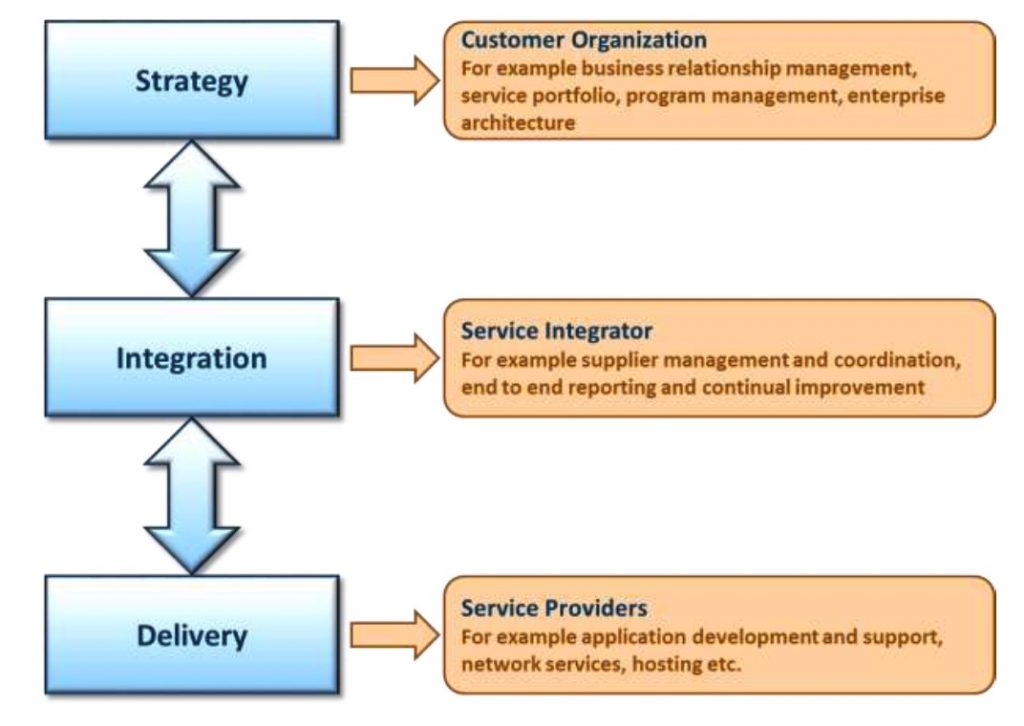IT organizations are outsourcing increasingly more services. This raises the question: how do you keep your service quality high when you’re working internal and external service providers? SIAM was developed in response to this question. But what is it? And how do you implement it?
Why was SIAM developed?
In the past, IT organizations did a lot of work themselves, from racking servers to replacing backup tapes. The pace at which technology is changing, is forcing IT organizations to call on outside expertise more often.
The trend over the past decades has been to outsource increasingly more IT services. For example, we see cloud storage being used more often, and the same goes for Software as a Service. How do you maintain an end-to-end overview with so many suppliers involved? How do you prevent them from working in silos leading to unnecessarily high costs for you?
SIAM was developed in response to questions like these. SIAM stands for Service Integration and Management. In insider jargon: SIAM is aimed at enabling IT organizations to manage the supply chain process end to end in a multi-sourced environment. In everyday language: SIAM is a methodology for organizations that work with many different suppliers and want to deal with this process in a smarter and more efficient way.

What is SIAM?
In a nutshell, SIAM’s message is: ensure that someone coordinates all the parties that deliver services to you. This responsibility may lie with a person, a team, a department or even an external party.
SIAM identifies 3 roles in an organization:

- customer organization (strategic): this is the customer of the organizations providing the services. It determines the strategy and, for example, chooses what type of work can – and cannot – be outsourced, and what the applicable criteria are.
- service providers (operational): every internal or external party that delivers a service to the customer organization. Ranging from departments like IT, Facility Management and HR to hardware suppliers, telecom providers and caterers.
- service integrator (tactical): the role responsible for the delivery of services and for reciprocal collaboration between service providers. This service integrator can be a person, team, department or external party.
Here you’ll find an overview of more ITSM terms you should know.
What is a service integrator?
The service integrator role is a distinctive feature of SIAM. This role has various forms and the choice depends on what works best for your organization.
External service integrator
- What is it? You hire an external firm to coordinate all the parties involved.
- Benefits: all the benefits of outsourcing, i.e. people and expertise are immediately available and the contract is flexible.
- Disadvantages: you rely heavily on an external party that coordinates all other external – and internal – parties. This demands excellent collaboration and a high-trust relationship. If it goes wrong, all hell breaks loose. In addition, this solution doesn’t come cheap.
Internal service integrator
- What is it? You appoint a person or team inside your organization to coordinate all parties.
- Benefits: you yourself have full control of all services, and it is easier for you to ensure that the services delivered and your business goals are in alignment. Due to government regulations, some organizations have no choice other than to take on the role of service integrator themselves.
- Disadvantage: you run the risk that the party acting as internal service integrator is not taken seriously by teams that previously coordinated suppliers.
Hybrid service integrator
- What is it? You yourself coordinate the service providers, supported by external staffing capacity.
- Benefits: you yourself have control of all services, but you make use of external people and expertise. This can be a first step towards later taking on the role of service integrator internally, something for which you currently don’t have the staffing capacity.
- Disadvantages: at the start, it will cost you extra time and money because you’re not only doing work yourself, but you’re also paying an external party to support you.
Lead supplier as service integrator
- What is it? One of your service providers acts as your service integrator. This is often a supplier that you already have close contact with, and collaborate with at the strategic level.
- Benefits: all the benefits of outsourcing, with the added bonus that this supplier already knows your organization well.
- Disadvantages: risk of conflicts of interest. The supplier acting as service integrator is tasked with optimally coordinating all parties on behalf of your company, but also wants to continue to deliver its own services. A high-trust relationship is required for this construction to work.
How do you implement SIAM?
The SIAM Body of Knowledge describes in detail how SIAM is implemented. To summarize:
- Discovery & Strategy: map your current situation and formulate the goals and strategy of your SIAM project.
- Plan & Build: translate your strategy into a plan for your SIAM transformation. In this stage, you also need to acquire all necessary approvals.
- Implement: implement your plan, resulting in a functioning and operational SIAM model.
- Run & Improve: monitor operational services delivery and everything this involves, and keep on continuously improving.
These stages are quite generic. Would you like to learn more about how SIAM is implemented? Read Scopism’s SIAM Body of Knowledge here. In this free download, you can find out, among other things, what meetings you should hold, what roles fall under the new function and what responsibilities lie with the customer organization.
ITIL and SIAM
ITIL v3 mainly contains best practices for collaborating with a single supplier. A major element is that, in consultation with your suppliers, you set down the delivery terms and conditions for the services they provide to you. You draw up underpinning contracts with external parties, and OLAs (operational level agreements) with internal parties.
But how do you coordinate multiple suppliers in a smart way? ITIL v3 doesn´t really say anything about this.
Moreover, ITIL 4 Foundation, that was published earlier this year, makes few concrete references to SIAM. Although it´s said that ITIL 4 links up well with concepts like DevOps, Agile and SIAM, they actually are hardly touched on. Perhaps it will happen in a follow-up to the Foundation level.
How does SIAM work in practice?
Let me dispel a misconception: a completely ‘SIAM-proof’ organization is hard to find. Getting SIAM to work well is actually no easy task. Your goal is to improve collaboration between all your service providers. These can easily number anywhere from several dozen to several hundred parties. It’s often hard enough to set up smooth collaboration with just one party.
Challenges when implementing SIAM
When you try to improve collaboration between different service providers, you run up against certain things:
- It’s extremely difficult to get different suppliers to follow the same processes. Every department and organization already has their own working method and they won’t give it up easily.
- Every party has their own tools and reports. This makes centralizing your reporting very hard and time intensive.
- Some parties are reluctant to collaborate intensively. They meet their contractual obligations, but they can’t – or won’t – invest time in jointly exploring ways to improve their service delivery.
Where do you start? This is the first step.
Do you want to improve collaboration with your service providers? You don’t necessarily have to implement SIAM for this. Start small.
Determine which of your suppliers are ‘strategic suppliers’. The Kraljic Matrix can be of help. Your strategic suppliers are those that have the highest supply risk and the highest profit impact.
Schedule a meeting with one of your strategic suppliers. Discuss what you can do to improve collaboration. Later on, you can use your collaboration with that supplier to determine how you can improve collaboration with other parties.
Would you like to learn more about smart collaboration with suppliers?
Read the following blogs:
- Blog: Barclay Rae on SIAM, including several tips and common pitfalls.
- Blog: Save costs on your supplier contracts? Do these 3 things!
转:What is SIAM: Service Integration and Management?
https://blog.topdesk.com/en/what-is-siam
